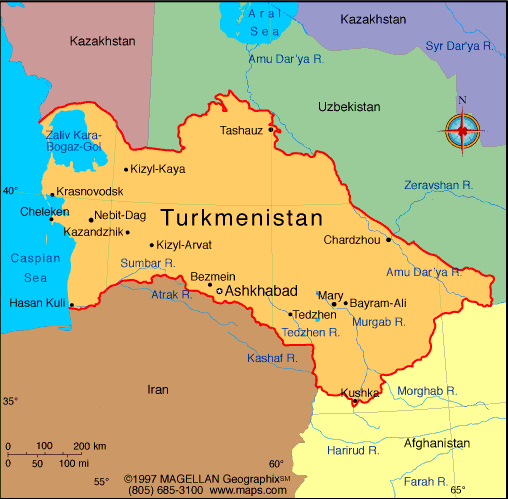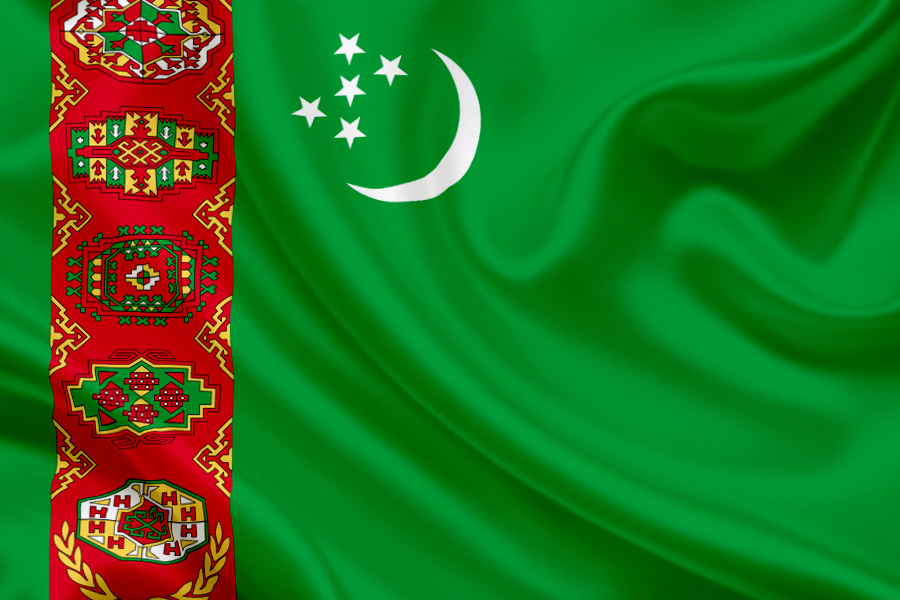About Turkmenistan
Turkmenistan is a country in Central Asia bordered by the Caspian Sea and largely covered by the Karakum Desert. It’s known for archaeological ruins including those at Nisa and Merv, major stops along the ancient trade route the Silk Road. Ashgabat, the capital, was rebuilt in Soviet style in the mid-20th century and is filled with grand monuments honoring former president Saparmurat Niyazov.
Turkmenistan has long served as a thoroughfare for other nations and cultures. Merv is one of the oldest oasis-cities in Central Asia, and was once the biggest city in the world. It was also one of the great cities of the Islamic world and an important stop on the Silk Road. Annexed by the Russian Empire in 1881, Turkmenistan figured prominently in the anti-Bolshevik movement in Central Asia. In 1925, Turkmenistan became a constituent republic of the Soviet Union, the Turkmen Soviet Socialist Republic (Turkmen SSR); it became independent after the dissolution of the Soviet Union in 1991. Turkmenistan possesses the world's fifth largest reserves of natural gas. Most of the country is covered by the Karakum Desert. From 1993 to 2017, citizens received government-provided electricity, water and natural gas free of charge.
Turkmenistan is an observer state in the Organisation of Turkic States, the Türksoy community and a member of the United Nations. It is also the only permanent neutral country recognized by the UN General Assembly in Asia.
The country is widely criticized for its poor human rights, its treatment of minorities, press and religious freedoms. Since independence from the Soviet Union in 1991, Turkmenistan has been ruled by repressive totalitarian regimes, that of President for Life Saparmurat Niyazov (also known as Türkmenbaşy or "Head of the Turkmens") until his death in 2006, Gurbanguly Berdimuhamedow, who became president in 2007 after winning a non-democratic election (he had been vice-president and then acting president previously) and ruled the country until he stepped down in 2022 in favour of his son Serdar, who won a subsequent presidential election described by international observers as neither free nor fair. The use of the death penalty was suspended in 1999, before being formally abolished in 2008.
Currency
The manat is the currency of Turkmenistan. The original manat was introduced on 1 November 1993, replacing the rouble at a rate of 1 manat = Rbls 500. The manat is subdivided into 100 tenge. Due to heavy inflation a new manat was introduced on 1 January 2009 at the rate of 5,000 old manats to 1 new manat.

Climate
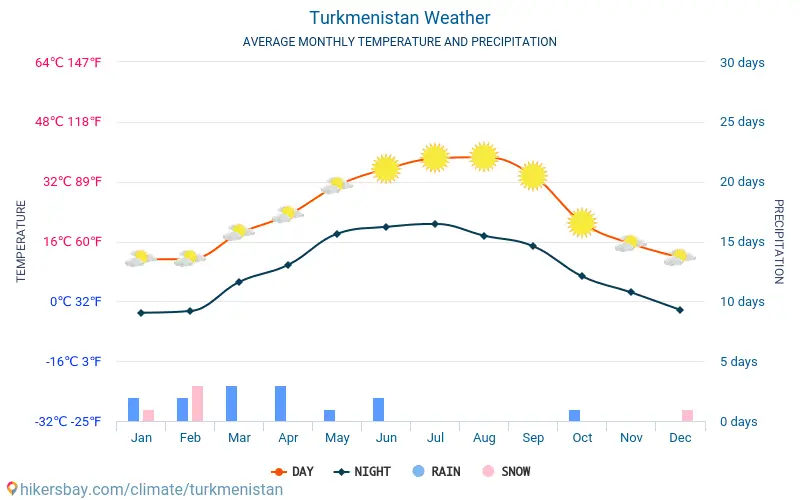
Turkmenistan is in a temperate desert zone with a dry continental climate. Remote from the open sea, with mountain ranges to the south and southeast, Turkmenistan's climate is characterized by low precipitation, low cloudiness, and high evaporation. Absence of mountains to the north allows cold Arctic air to penetrate southward to the southerly mountain ranges, which in turn block warm, moist air from the Indian Ocean. Limited winter and spring rains are attributable to moist air from the west, originating in the Atlantic Ocean and Mediterranean Sea. Winters are mild and dry, with most precipitation falling between January and May. The Kopet Dag Range receives the highest level of precipitation.
The Karakum Desert is one of the driest deserts in the world; some places have an average annual precipitation of only 12 mm (0.47 in). The highest temperature recorded in Ashgabat is 48.0 °C (118.4 °F) and Kerki, an extreme inland city located on the banks of the Amu Darya river, recorded 51.7 °C (125.1 °F) in July 1983, although this value is unofficial. 50.1 °C (122 °F) is the highest temperature recorded at Repetek Reserve, recognized as the highest temperature ever recorded in the whole former Soviet Union. Turkmenistan enjoys 235–240 sunny days per year. The average number of degree days ranges from 4500 to 5000 Celsius, sufficient for production of extra long staple cotton.
Turkmenistan contains seven terrestrial ecoregions: Alai-Western Tian Shan steppe, Kopet Dag woodlands and forest steppe, Badghyz and Karabil semi-desert, Caspian lowland desert, Central Asian riparian woodlands, Central Asian southern desert, and Kopet Dag semi-desert. Turkmenistan's greenhouse gas emissions per person (17.5 tCO2e) are considerably higher than the OECD average: due mainly to natural gas seepage from oil and gas exploration.
Language
Turkmen language, member of the Turkic language family within the Altaic language group. Turkmen is spoken in Turkmenistan, in parts of neighbouring Kazakhstan and Uzbekistan, and, by fewer people, in Iran and Afghanistan.
Economy
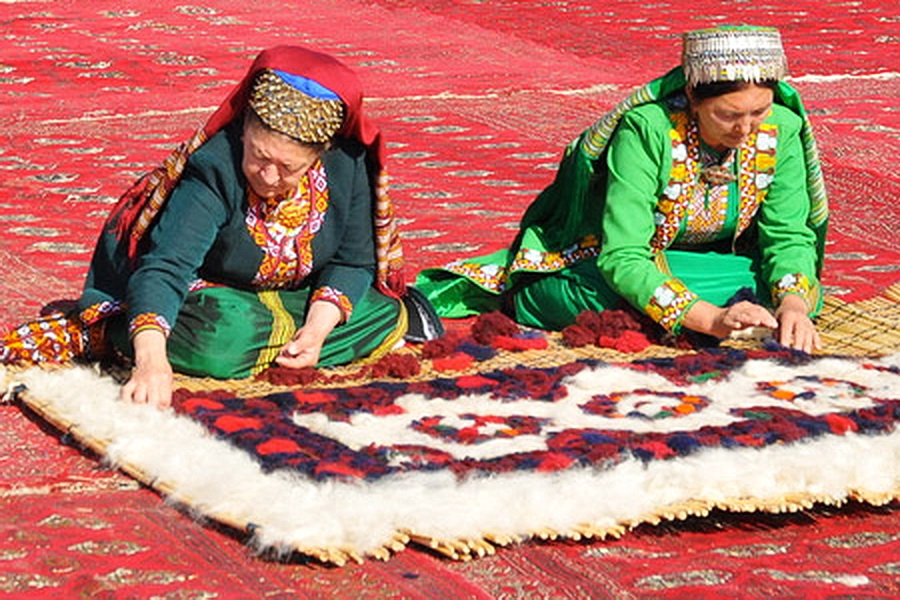
The country possesses the world's fourth largest reserves of natural gas and substantial oil resources. Turkmenistan has taken a cautious approach to economic reform, hoping to use gas and cotton sales to sustain its economy. In 2014, the unemployment rate was estimated to be 11%. Between 1998 and 2002, Turkmenistan suffered from the continued lack of adequate export routes for natural gas and from obligations on extensive short-term external debt. At the same time, however, the value of total exports rose sharply due to increases in international oil and gas prices. The subsequent collapse of both hydrocarbon and cotton prices in 2014 cut revenues from export sales severely, causing Turkmenistan to run trade deficits from 2015 through 2017. Economic prospects in the near future are discouraging because of widespread internal poverty and the burden of foreign debt, coupled with continued low hydrocarbon prices and reduced Chinese purchases of natural gas. One reflection of economic stress is the black-market exchange rate for the Turkmen manat, which though officially set at 3.5 manats to the US dollar, reportedly was trading in January 2021 at 32 manats to the dollar.
President Niyazov spent much of the country's revenue on extensively renovating cities, Ashgabat in particular. Corruption watchdogs voiced particular concern over the management of Turkmenistan's currency reserves, most of which are held in off-budget funds such as the Foreign Exchange Reserve Fund in the Deutsche Bank in Frankfurt, according to a report released in April 2006 by London-based non-governmental organization Global Witness. According to a decree of the Peoples' Council of 14 August 2003, electricity, natural gas, water and salt were to have been subsidized for citizens until 2030. Under implementing regulations, every citizen was entitled to 35 kilowatt hours of electricity and 50 cubic meters of natural gas each month. The state also provided 250 liters (66 gallons) of water per day. As of 1 January 2019, however, all such subsidies were abolished, and payment for utilities was implemented.
Health
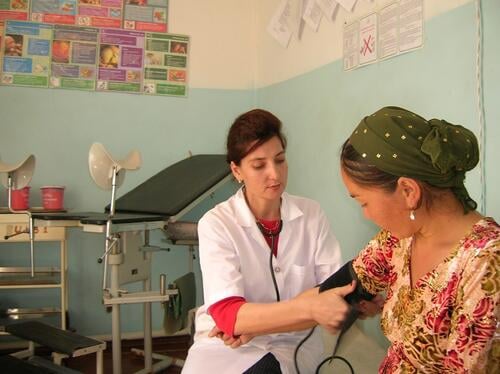
The health system of Turkmenistan is organized on a national basis. Whilst policy making for the health sector comes under the ambit of the Cabinet of Ministers, the Ministry of Health and Medical Industry is responsible for the actual operation of health services. In each of the country’s five velayats (regions), the velayat hakim (provincial governor), a presidential appointee, finances regional health services.
Education
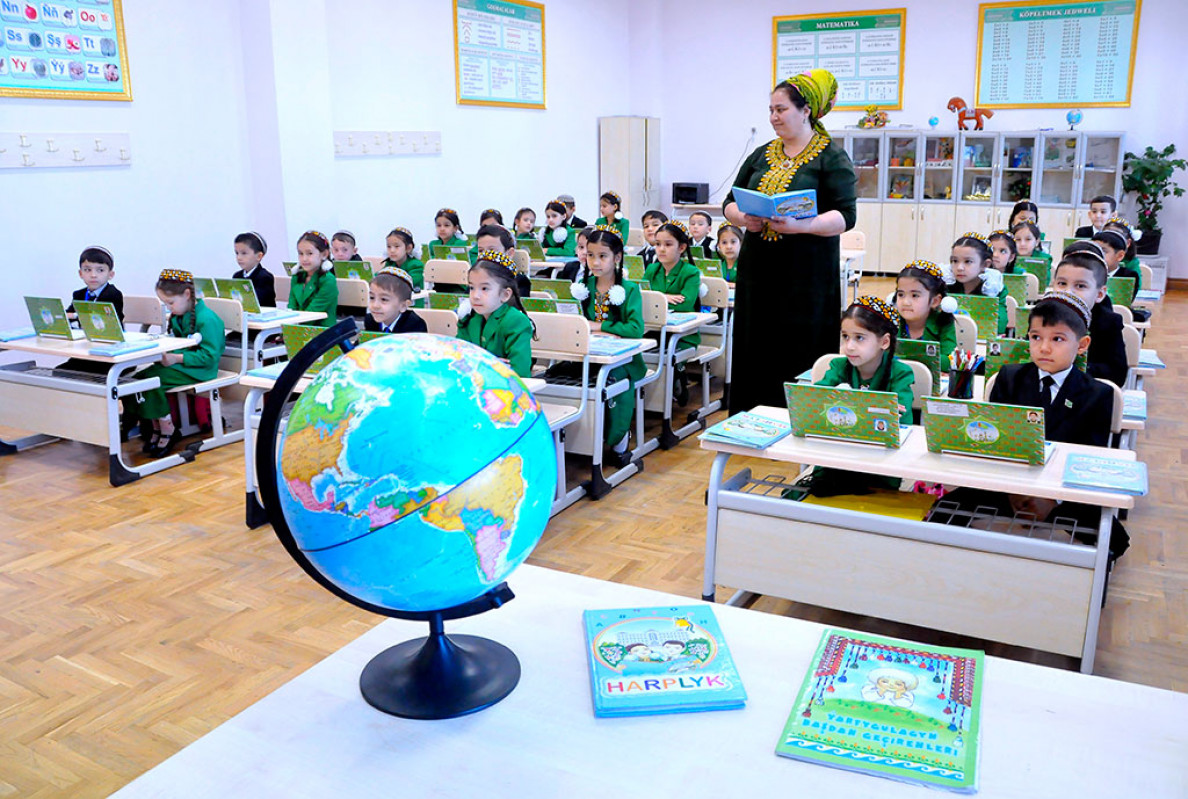
Education is universal and mandatory through the secondary level. Under former President Niyazov, the total duration of primary and secondary education was reduced from 10 to 9 years. President Berdimuhamedov restored 10-year education as of the 2007–2008 school year. Effective 2013, general education in Turkmenistan was expanded to three-stages lasting 12 years: elementary school (grades 1–3), high school – the first cycle of secondary education with duration of 5 years (grades 4–8), and secondary school (grades 9–12) At the end of the 2019–20 academic year, nearly 80,000 Turkmen pupils graduated from high school. As of the 2019–20 academic year, 12,242 of these students were admitted to institutions of higher education in Turkmenistan. An additional 9,063 were admitted to the country's 42 vocational colleges. An estimated 95,000 Turkmen students were enrolled in institutions of higher education abroad as of Autumn 2019.
Culture
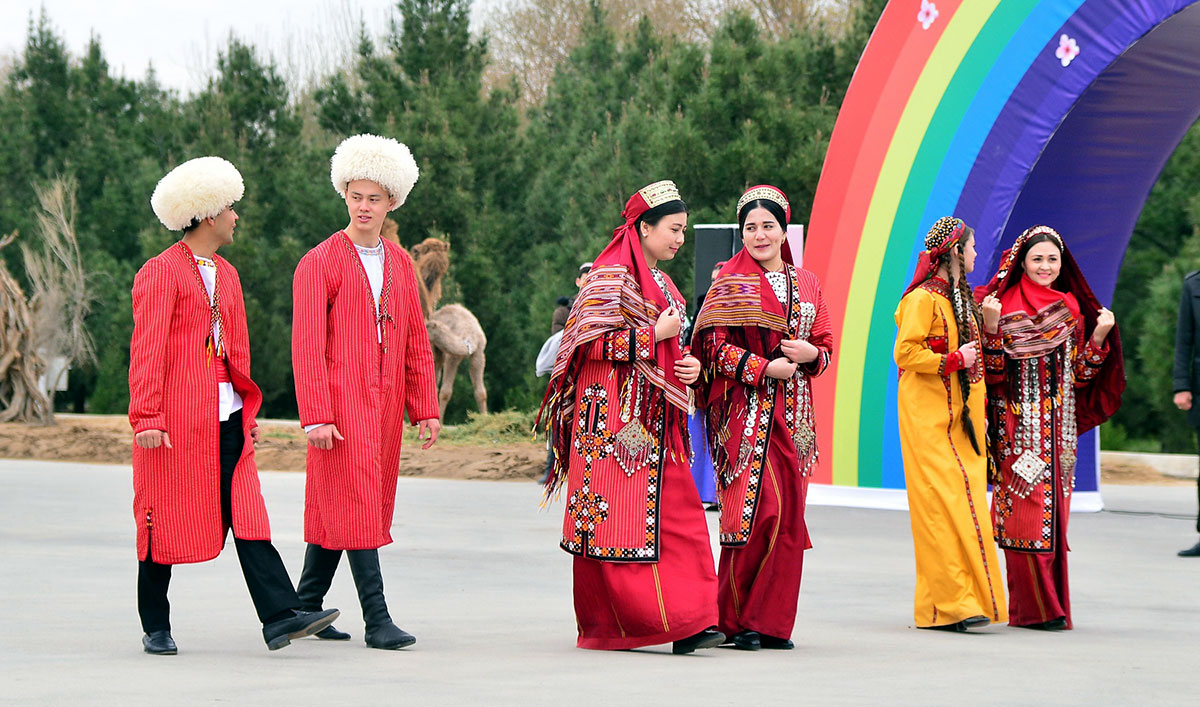
The Turkmen people have traditionally been nomads and equestrians, and even today after the fall of the USSR attempts to urbanize the Turkmens have not been very successful. They never really formed a coherent nation or ethnic group until they were forged into one by Joseph Stalin in the 1930s. Rather they are divided into clans, and each clan has its own dialect and style of dress. Turkmens are famous for making knotted Turkmen carpets, often mistakenly called Bukhara rugs in the West. These are elaborate and colorful hand-knotted carpets, and these too help indicate the distinctions among the various Turkmen clans. Ethnic groups throughout the region build yurts, circular houses with dome roofs, made of a wooden frame covered in felt from the hides of sheep or other livestock. Horses are an essential ingredient of recreational activities in most of the region, in such games as horseback fighting, in which riders grapple to topple each other from their horses; horse racing. Turkmen men wear traditional telpek hats, which are large black or white sheepskin hats. Traditional dress for men consists of these high, shaggy sheepskin hats and red robes over white shirts. Women wear long sack-dresses over narrow trousers (the pants are trimmed with a band of embroidery at the ankle). Female headdresses usually consist of silver jewelry. Bracelets and brooches are set with semi-precious stones.
Cuisine
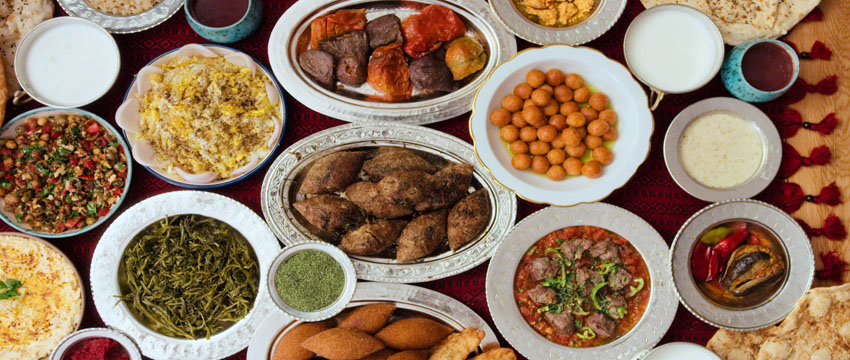
Manti are dumplings filled with ground meat, onions or pumpkin. Shurpa is a meat and vegetable soup. A wide variety of filled pies and fried dumplings are available in restaurants and bazaars, including somsa, gutap (often filled with spinach), and ishlykly. These are popular with travelers and taxi drivers, as they can be eaten quickly on the run, and are often sold at roadside stands. Turkmen cuisine does not generally use spices or seasonings, and is cooked with large amounts of cottonseed oil for flavor.
Chegdermeh, a mixture of rice, meat, tomato and onions, is a uniquely Turkmen dish. Shashlyk, skewered chunks of mutton, lamb, chicken, or sometimes fish, grilled over charcoal and garnished with raw sliced onion and a special vinegar-based sauce, is served in restaurants and often sold in the street. Restaurants in Turkmenistan serve mainly Russian fare such as pelmeni, buckwheat (grechka), golubtsy, and a wide variety of mayonnaise-based salads. Lagman, a Uyghur noodle dish, can also be found in some areas.


